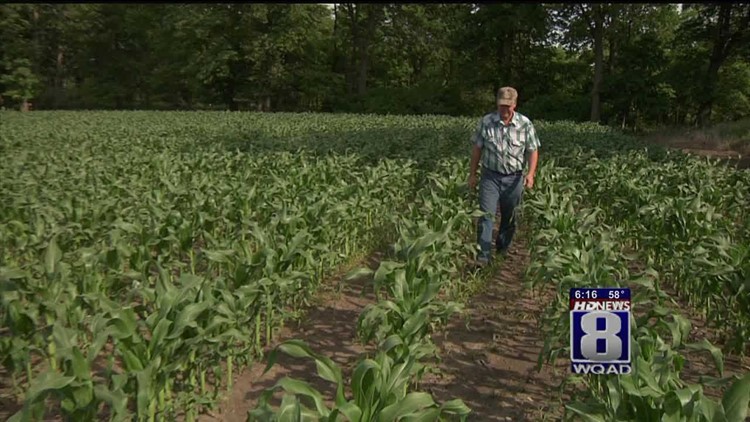Perhaps Iowa farmers’ biggest fear is becoming a harsh reality: The escalating U.S.-China trade dispute erupted Friday, with each country vowing to levy 25 percent tariffs on $50 billion in goods.
U.S. and Iowa agriculture is caught in the crossfire, with farmers selling $14 billion in soybeans to China last year, its top export market.
Soybeans are among hundreds of U.S. products China has singled out for tariffs. The U.S. has an equally long list that includes taxing X-ray machines and other Chinese goods.
Iowa farmers could lose up to $624 million, depending on how long the tariffs are in place and the speed producers can find new markets for their soybeans, said Chad Hart, an Iowa State University economist.
U.S. soybean prices have fallen about 12 percent since March, when the U.S.-China trade dispute began.
“Any tariff or tax put in place will have a significant impact, not only to the U.S. soybean market but to Iowa’s, because we’re such a large producer,” Hart said Friday.
Iowa is the nation’s second-largest soybean grower, producing 562 million bushels last year worth $5.2 billion.
“It will slow down the market. Even with the tariffs in place, we will ship a lot of soybeans to China,” Hart said. “It just won’t be nearly the amount we did before.
“It’s likely to still be our largest market even with these tariffs in place.”
On Friday, President Donald Trump said the U.S. will place 25 percent tariffs on $50 billion of Chinese goods. China quickly vowed to match Trump’s action.
The U.S. tariffs are a response to “China’s theft of intellectual property and technology,” Trump said in a statement.
Trump also is looking for tariffs on another $100 billion of Chinese products. And U.S. tariffs on steel and aluminum imports have sparked retaliatory tariffs.
China already has smacked farmers with an additional 25 percent tariff on pork, and Mexico plans a 20 percent tariff on ham and pork shoulders.
Those moves could cost Iowa pork producers $360 million over the year, an ISU economist estimates, less than initially calculated, thanks to some pork price recovery.
Mexico is weighing tariffs on $4 billion of U.S. corn and soybeans, Reuters reported Friday, while the European Union and Canada are considering tariffs on a range of U.S. products.
Escalating trade disputes come as farm income has tumbled with falling commodity prices: U.S. farm income has been cut in half over the past five years, while Iowa farmers’ income shrank nearly 75 percent.
“This is not the news farmers wanted to see, especially with the struggles we’ve had … over the past four or five years,” Hart said.
Grant Kimberley, director of market development at the Iowa Soybean Association, said farmers are holding out hope that trade disputes are resolved before the July deadline — or are short-lived if they go into place.
Like others, Kimberley, who farms with his family in Polk County, believes China is as reluctant as the U.S. to lose soybean trade.
China, with a population of more than 1.4 billion, imports 62 percent of the world’s soybean production. About 40 percent of China’s soybean imports come from the U.S.
Tariffs could slash U.S. soybean exports to China by about 65 percent, as other countries’ soybeans become a better buy, a Purdue University study said.
It shows losses for U.S. farmers could range from $1.7 billion to $3.3 billion with tariffs up to 30 percent.
“You can’t make business decisions with this kind of uncertainty. … it will be difficult not just for farmers, but ag lenders, equipment manufacturers, seed companies,” Kimberley said. “It impacts everybody.”
Secretary Sonny Perdue said Friday the U.S. Department of Agriculture is assessing the tariffs’ impact on farmers, given “the president’s promise not to make farmers bear the brunt of these trade disruptions.”
Perdue said the Commodity Credit Corp., USDA agency that has broad authority to support farm prices and incomes, is among “the tools available” but provided no details.
“It’s way too early” to determine the financial hit, said Perdue, who met Friday with Minister Lawrence MacAulay, Canada’s agriculture minister on Prince Edward Island.
“We’ll look and see what the market damage is from the trade disruptions. And then we’ll make a calculation and a determination in conjunction with the White House and Congress,” said the former Georgia governor.
Hart said reduced China demand and lower prices for soybeans will help drive increased demand from other global markets.
“The product that used to go to China will go to Europe, will go to North Africa, as we find those other markets,” he said.
But, Kimberley said, “nothing can replace China.”
And U.S. farm competitors will swoop in to capture as much of the Chinese soybean market as possible.
“It will be South America — Brazil and Argentina — and parts of western Europe — Russia and the Ukraine — that win,” Kimberley said.
“U.S. or China won’t win,” he said. “And the U.S. and Canada and Mexico won’t win if those tariffs go in place long-term.”



